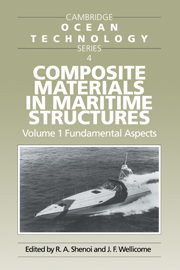Book contents
- Frontmatter
- Contents
- Preface
- List of Authors
- 1 A Strategic Overview
- 2 Background to Materials Science
- 3 Environmental Aspects
- 4 Production by Resin Transfer Moulding
- 5 An Engineering Approach to the Prediction of Elastic Properties of a Laminate
- 6 Mechanics of Orthotropic Laminae
- 7 Analysis of Laminated Composites
- 8 Theory of Sandwich Beams and Plates
- 9 Design of Anisotropic Panels
- 10 Finite Element Analysis of Composites
- 11 Theoretical Predictions of Failure Mechanisms and Strength
- 12 Considerations of Failure Theories in Design
- 13 The Procedures and Standards
- Appendix
- Index
12 - Considerations of Failure Theories in Design
Published online by Cambridge University Press: 04 August 2010
- Frontmatter
- Contents
- Preface
- List of Authors
- 1 A Strategic Overview
- 2 Background to Materials Science
- 3 Environmental Aspects
- 4 Production by Resin Transfer Moulding
- 5 An Engineering Approach to the Prediction of Elastic Properties of a Laminate
- 6 Mechanics of Orthotropic Laminae
- 7 Analysis of Laminated Composites
- 8 Theory of Sandwich Beams and Plates
- 9 Design of Anisotropic Panels
- 10 Finite Element Analysis of Composites
- 11 Theoretical Predictions of Failure Mechanisms and Strength
- 12 Considerations of Failure Theories in Design
- 13 The Procedures and Standards
- Appendix
- Index
Summary
INTRODUCTION
The physical basis of failure theories has been discussed in Chapter 11, and a more general summary is also provided by Raghava. The purpose of this Chapter is to suggest how failure theories may be used and the extent of their relevance in the design of conventional ship structures.
This Chapter also includes a discussion of the practical modes of failure that may be expected in FRP marine structures and how the designer may avoid them.
FAILURE THEORIES AND CRITERIA
When the procedures for structural design of FRP vessels were developed in the 1960s and 1970s the science of failure of composites was in its infancy and was not, in general, acknowledged by shy) designers. The failure of FRP structures was understood in a very simplistic manner and on the whole viewed uniaxially in compression and tension.
This view was not, and indeed is not, as blinkered as it may seem. Irrespective of the material of which a ship's hull is fabricated the predominant stresses in most of the primary structure are uniaxial. Even when in-plane compression and tension are superimposed on lateral loads, the direction of stiffening ensures that the significant stresses are still in one direction.
In addition to the loading being mainly uniaxial, critical modes of failure frequently involve elasto-plastic buckling due to compressive wave loading rather than material failure, and so again, traditional failure theories are inappropriate even for metal structures. For FRP where the stiffness is much less and no yielding can exist, failure tends mainly to be by elastic buckling and much of the development effort has gone into an understanding of that phenomenon.
- Type
- Chapter
- Information
- Composite Materials in Maritime Structures , pp. 308 - 315Publisher: Cambridge University PressPrint publication year: 1993



